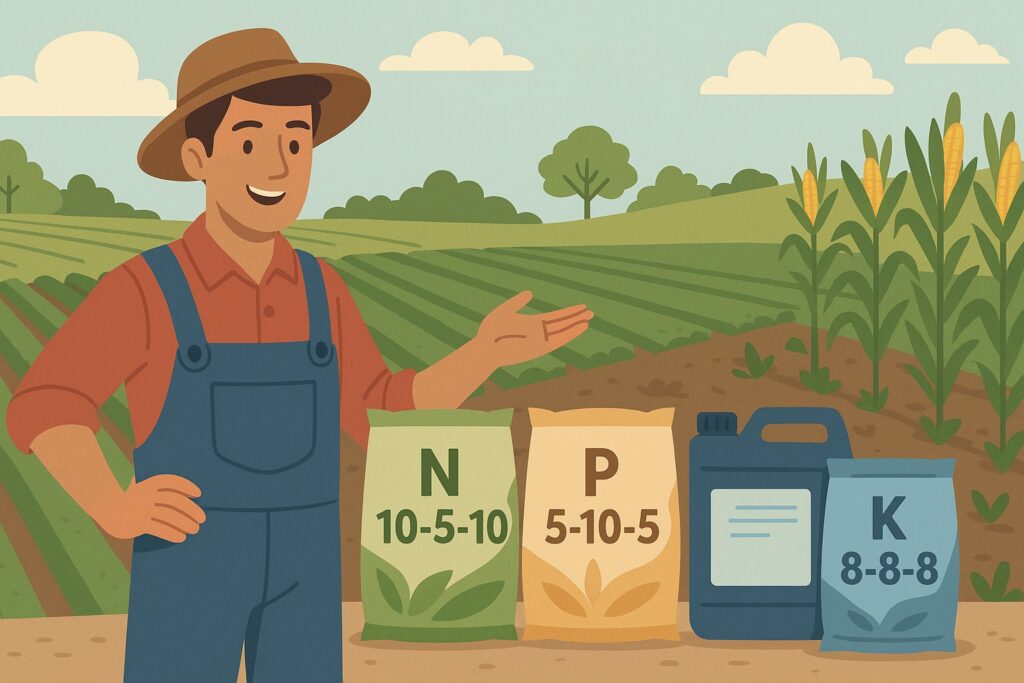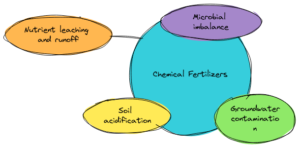The global demand for food production has prompted farmers to maximize yields, but not all fertilizers are equally effective. Understanding the difference between organic and chemical fertilizers isn’t just about choosing a farming input — it’s about understanding soil biology, crop nutrition, long-term productivity, and environmental impact.
Plants need fertilisers as food, however there are wide variations in the way and effects of how those nutrients are delivered. While some decompose gradually and improve the soil, others produce immediate benefits but may have long-term effects. In order to help you make wise decisions about what you put into your soil and how it affects the health of your plants, land, and business, this blog dissects the differences.
What Are Organic Fertilizers?
Natural materials, known as organic fertilizers, provide nourishment for plants and soil microorganisms. They originate from mineral sources, animal waste, or degraded plants. Fish emulsion, vermicompost, green manure, compost, bone meal, and seaweed extract are a few examples.
Their primary functions are to enhance the organic matter of the soil, boost microbial activity, and gradually release nutrients. Because organic fertilisers depend on microbial degradation to become plant-accessible, the nutrients are not instantly available.
For long-term soil development and comprehensive nutrient cycling, organic fertilisers are particularly helpful. They are used by farmers to enhance soil structure, improve moisture retention, promote biodiversity, and promote growth. By choosing to Buy Organic Farming Products, farmers and gardeners support a more regenerative approach, aligning crop nutrition with ecological integrity and sustainable yield.
What Are Chemical Fertilizers?
Chemical fertilizers, often referred to as synthetic fertilizers, are produced through industrial processes that frequently utilize resources derived from mining or petroleum. In addition to secondary and micronutrients, these fertilisers include extremely concentrated versions of nitrogen, phosphorus, and potassium (NPK).
Urea, potassium chloride, ammonium nitrate, and superphosphate are a few examples. These inputs are fast-acting and ideal for prompt plant responses, as they dissolve instantly in water.
However, their overuse can lead to:
Chemical fertilisers supply nutrients to plants directly, avoiding soil life. Although they work well in the near term, they frequently deteriorate the quality of the soil over time and need larger quantities to produce consistent effects.
Also Read:How Do You Maintain a Drip Irrigation System After Installation?
Nutrient Composition and Release Rates
The key difference between organic and chemical fertilizers lies in how they deliver nutrients and interact with the soil.
|
Feature |
Organic Fertilizers | Chemical Fertilizers |
| Source | Plant, animal, or mineral origin |
Synthetic compounds or processed minerals |
|
Nutrient Release |
Slow, microbial-driven | Immediate, water-soluble |
| Nutrient Content | Lower but balanced |
Higher, targeted NPK values |
|
Soil Impact |
Improves structure and microbial life | Can degrade soil over time |
| Risk of Overuse | Minimal |
High; leads to toxicity or leaching |
|
Longevity |
Long-term soil health |
Short-term crop growth |
Chemical fertilizers may have precise NPK values, but they often ignore the broader ecosystem needs of the soil. Organic fertilizers, although slower in action, nourish the soil to support plant growth.
Soil Health and Microbial Life
Soil serves as more than just a plant anchor. Bacteria, fungus, nematodes, and microfauna make up this living environment, which promotes root development, inhibits diseases, and facilitates nutrient intake.
By introducing carbon, promoting microbial diversity, and establishing long-term nutrient cycling, organic fertilisers help sustain this life. For instance, the beneficial bacteria and fungi found in compost inhibit disease and release minerals from soil particles.
However, microbial populations are frequently disturbed by chemical fertilisers. Their high acidity and salt concentration lead to microbial die-off and a reduction in biodiversity. Compacted, dead soil that is reliant on outside inputs might result from repeated use.
This degradation is why organic practices are increasingly used even in conventional systems, looking to improve soil resilience and reduce fertilizer dependency.
Healthy soil grows healthy crops. Fertilizer should be a partner, not a crutch.
Environmental and Water Impact
One of the main global sources of water contamination is agriculture runoff. Because chemical fertilisers are so liquid, extra nutrients can be readily washed into rivers, lakes, and groundwater by rain or overwatering.
Eutrophication, or the rapid growth of algae that suffocates aquatic life, is caused by this runoff. Human and animal health issues have been connected to nitrate poisoning in drinking water.
Because organic fertilisers are less mobile in the soil, they present a smaller risk to the environment. Their organic matter-bound nutrients are released gradually, reducing leaching and runoff.
To further lessen their impact on the environment, organic farming methods frequently incorporate buffer zones, composting, and water-saving strategies.
According to a report by the World Resources Institute, farms using organic nutrient management reduce nitrogen runoff by up to 60% compared to conventional operations.
Crop Quality and Yield
Because chemical fertilisers result in rapid, noticeable growth, they are frequently utilized. Fruits get larger, leafy greens get darker, and yields may increase. However, this benefit frequently has a price: shallow root systems, decreased nutrient density, and heightened susceptibility to pests and illnesses.
Over time, organic fertilisers improve nutrient uptake and root development. Although they may develop a little more slowly, crops are usually more hardy and have higher levels of secondary metabolites, such as antioxidants, which enhance flavour and nutrition.
Organic systems may produce less in the first one to two years, but by the third year, they catch up, according to a number of side-by-side experiments. Because they retain soil moisture better, they also perform better in areas that are prone to drought.
When judged on nutrient per acre rather than tonnage per acre, organic systems are competitive — especially when factoring in long-term soil regeneration.
Cost and Accessibility
Chemical fertilisers are frequently less expensive up front and need less work to apply. They are therefore desirable for time-sensitive applications or extensive monocultures.
Long-term reliance on artificial inputs, however, might be costly. More fertiliser is required for depleted soil, creating an expensive feedback loop. Hidden costs are also increased by application, storage, and transportation.
Although sourcing, composting, and applying organic fertilizers may require more work, they are more economical in the long run, as they frequently utilize local waste streams, agricultural residues, or animal manures.
Utilising locally accessible organic inputs, such as vermicompost, neem cake, or cow manure, helps smallholder farmers become less reliant on outside sources.
Platforms like Rodale Institute and Organic Agriculture Centre of Canada provide farmer-accessible data on building effective organic fertility systems without high investment.
Policy and Certification Considerations
Detailed documentation, authorised input lists, and evidence of soil-building techniques are necessary for organic certification. A farm is instantly disqualified from organic certification if it uses chemical fertilisers.
Although not all farms opt for certification, adhering to organic practices, such as enhancing soil and avoiding synthetic inputs, puts growers in a position to satisfy growing consumer demands for sustainability and transparency.
The Paramparagat Krishi Vikas Yojana (PKVY) is encouraging organic clusters in nations like India by providing market access, training, and input subsidies. Similar laws promoting chemical-free farming are emerging in Southeast Asia and Europe.
FAQs
- Is it true that organic fertilizers don’t work as well as chemical ones?
Organic fertilizers work differently. They release nutrients slowly and support long-term soil fertility. While chemical fertilizers may produce faster results, organics build resilience and reduce input needs over time. - Can I use both organic and chemical fertilizers together?
Some farms use integrated nutrient management, combining both. However, this may disqualify them from organic certification. The best strategy depends on your goals, soil condition, and market. - Do chemical fertilizers kill earthworms?
Yes, high salt concentrations and acidity from repeated chemical use can reduce earthworm populations. Organic inputs like compost and mulch support their growth and activity. - Which is more sustainable long-term?
Organic fertilizers are more sustainable. They improve soil structure, retain water, and reduce environmental impact. Chemical fertilizers can degrade soil and require increasing inputs to maintain yield. - Are organic fertilizers enough for high-demand crops like tomatoes or corn?
Yes, when combined with good soil management and crop planning. Organic systems can support high-yield crops by using compost, liquid teas, and mineral amendments at key growth stages.
Looking Ahead: The Fertilizer Choice That Builds the Future
Fertiliser selection extends beyond NPK levels. They show how we view farming, how we handle soil, and how we prepare for the upcoming seasons. Chemical fertilisers concentrate on short-term plant feeding, whereas organic fertilisers maintain a live soil system.
The move to organic inputs isn’t just a preference for farmers who prioritise sustainability, nutrient density, and long-term productivity; it’s becoming essential. Organic systems provide the means to reestablish equilibrium, enhance production stability, and farm with reduced risks as soil deterioration and climate pressures intensify.
Every producer, whether on in small scale or a commercial scale, can make a better decision for their land, crops, and future by being aware of the differences.









Leave a Reply